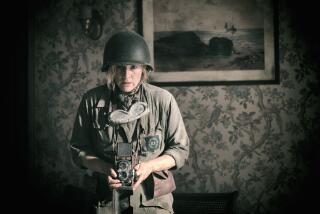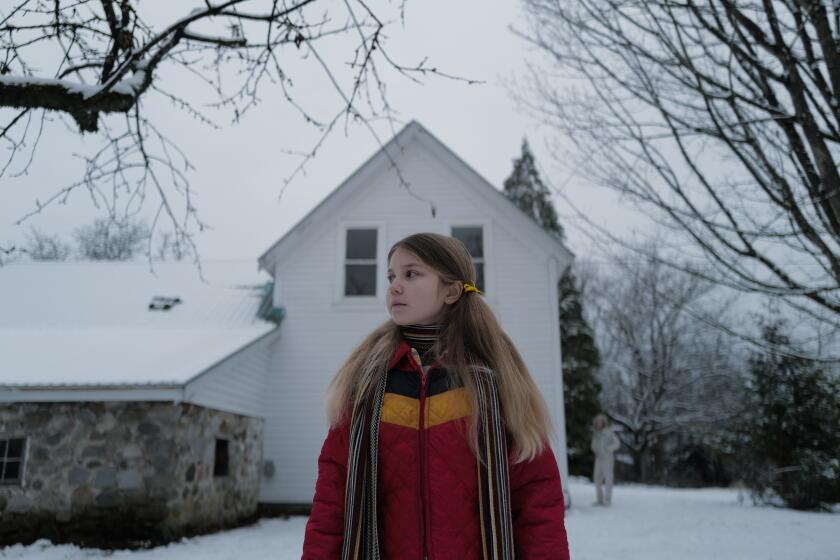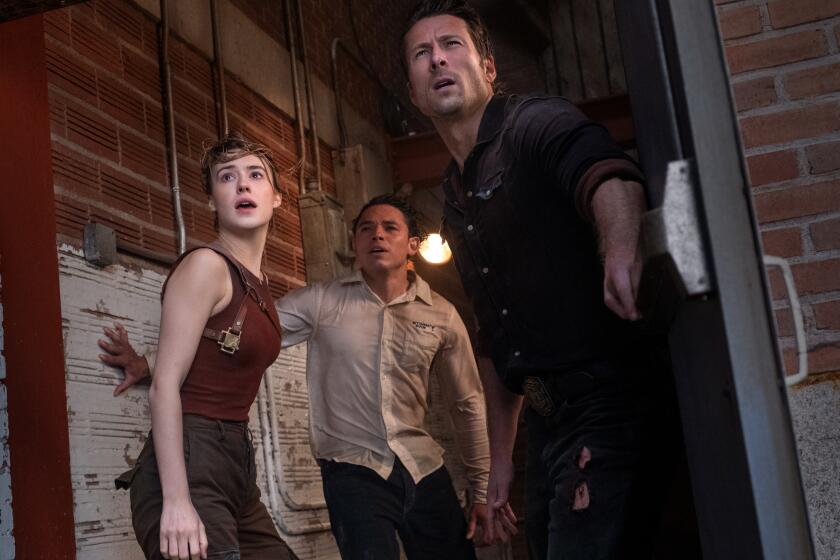Poetry in motion
In “Sunrise,” F.W. Murnau’s 1928 poetic fable of guilt and redemption, the filmmaker transports the audience, via a trolley ride, from the innocent pastoral beauty of the countryside to the city with its bright lights and glittering amusement zone. Murnau captures in striking detail the impact of this world on a farmer (George O’Brien) and his wife (Janet Gaynor) -- the lure of the city ultimately a seductive threat to the couple and their happiness. It remains one of the most striking moments in the silent cinema.
Murnau reverses direction in “City Girl,” a 1929 talkie in which a waitress (Mary Duncan) in a busy Chicago cafe imagines that life on a farm would be paradise in contrast to her hardscrabble urban existence with all its noise and pushing and shoving. Yet, as is often the case in Murnau’s world, reality collides with the imagined life, in this case as hardship and danger shadow the waitress after she accepts the proposal of a naive Minnesota farmer (Charles Farrell). Murnau makes the heat and sweat of a Chicago summer as palpable as the severe environment of her harsh new life, its people shaped in varying ways by their eternal agrarian struggle with the capricious forces of nature.
As a film, “City Girl” is as obscure as “Sunrise” is famous, even though it reveals Murnau taking the advent of sound in stride without diminishing the pictorial quality of his work. Both films will screen locally in separate events, along with other largely unfamiliar works by Murnau.
On Thursday, the Academy of Motion Picture Arts and Sciences, which has an exhibit of Murnau posters and photos, will screen “Sunrise,” a joint restoration project with the British Academy of Film and Television Arts. The film, which has a synchronized score, brought Gaynor the very first Oscar for her performance and for those in “Seventh Heaven” and “Street Angel” and one for its pioneering cinematographers, Charles Rosher and Karl Struss.
Indeed, in regard to cinematography, all Murnau films are marked by superbly evocative camerawork and production design -- the city in “Sunrise” is in fact a set -- crucial in creating a magical atmosphere.
Photographed by Ernest Palmer, the dynamic, sweeping “City Girl” screens April 3 as part of LACMA’s series “Halo of Dreams: The Films of F.W. Murnau.”
The German-born Murnau was a master of Expressionism with its stylized, distorted imagery that so acutely reflected the post-World War I economic and moral chaos of his native country. He was brought to Fox on the wake of his classic “The Last Laugh” (1926) with its unforgettable image of Emil Jannings, so proud in his elaborate gold-braided uniform as the doorman of a grand Berlin hotel, suddenly reduced to a humbled men’s room attendant. Murnau had already gained fame with his 1922 “Nosferatu,” still the greatest of all the Dracula films. The sight of Max Schreck’s cadaverous vampire standing on the deck of a pestilential ship bound for Bremen, where the count’s great love resides, remains one of the movie’s most indelible images, the embodiment of isolation and loneliness and longing.
Born Friedrich Wilhelm Plumpe in Germany in 1888, Murnau studied art and literature at the University of Heidelberg and became a student and later an actor and assistant director to Max Reinhardt, making his film directorial debut in 1919. Murnau swiftly became part of the Golden Age of German Cinema’s great 1920s triumvirate that included G.W. Pabst and Fritz Lang. All three men were deeply responsive to the outburst of artistic experimentation that accompanied and reflected the instability of Germany in the 1920s. As sophisticated Europeans they shared a profound grasp of the psychology of sex.
Murnau was the first to come to Hollywood. He was only 42 when he was killed in an auto accident on March 11, 1931, while traveling from Los Angeles to Monterey. Lang would arrive in 1934 at the behest of David O. Selznick and enjoy two decades of success, whereas Pabst came to Hollywood in 1933 but was able to make only one film, and eventually he returned to Europe. Yet all three would affect the look and themes of Hollywood films, especially with the emergence of the film noir in which Lang would excel.
A haunting experience
The LACMA series commences Friday with the sprawling and melodramatic “Phantom.” Adapted by Thea von Harbou from Gerhart Hauptmann’s novel, “Phantom” is remarkable for the intensity of Murnau’s expressiveness and psychological insight. Unfolding in flashback, it tells of a humble city clerk (Alfred Abel, later the master of “Metropolis”) already deluded that he possesses poetic genius when he is struck by a phaeton driven by the angelic-looking daughter (Lya De Putti) of a rich family. He becomes haunted and undone by his recurring images of the radiant young woman in her phaeton passing through the town square like a goddess in a chariot. Reflective of the times, “Phantom” examines a society in such desperate straits that it is in danger of valuing money above all else.
A triumph of production design (by Hermann Warm of “The Cabinet of Dr. Caligari”), “Phantom” has remarkable sequences depicting the clerk’s fevered imagination and a cast of vivid characters, including Anton Edthofer as the oily gigolo of the clerk’s prosperous pawn broker-money lender aunt (Grete Berger). The film will be presented with live organ accompaniment by Robert Israel, who will be performing the eloquent score he composed for the film.
Murnau’s “Tabu” (1931) is a Romeo and Juliet-like poetic tragedy set in the South Seas, one in which a young pearl diver (Matahi) and a maiden (Anne Chevalier) defy the edict that has designated her a virgin princess. It represents an attempt to meld documentary and fiction. The late Floyd Crosby won an Oscar for his black-and-white cinematography.
In “The Burning Earth” (1922), Murnau tells a classic tale of a farmer’s son (Vladimir Gaidrow) who loses his perspective and corrupts his values. He marries the widow of a local count and becomes intent on exploiting recently discovered oil deposits on her land. This is one of those German films in which everyone is touched by an ancient curse and consumed with angst, none more so than this film’s antihero. A film with Murnau’s typical pictorial grandeur, “Burning Earth” is not as timeless as his more famous films but fascinating nonetheless.
Hints of Murnau’s illusive “4 Devils” can be found in “4 Devils: Traces of a Lost Film,” Janet Bergstrom’s scholarly attempt to give an idea of what this missing film is like through an assemblage of stills, augmented by sketches and by recitations of its detailed script.
Written by many hands under Murnau’s guidance, the film’s original ending was rejected by Fox, which led to several variations and a final deadly reworking, without Murnau, as a part-talkie. It’s a circus story in which a kindly clown becomes a foster father to two pairs of orphans, brothers and sisters, who grow up to form a daring trapeze act. The disappearance of the reworked version may be a blessing in disguise while the true value of “4 Devils” as Murnau conceived it will forever remain a question mark.
“The Last Laugh” and “Tartuffe,” both written by major screenwriter Carl Mayer, compose a double feature of Jannings, presenting the formidable actor in contrasting roles. He is as cunning in Murnau’s spare and stylized Moliere adaptation as he is defeated in the first film. Tartuffe (Jannings) maneuvers a takeover of the household of a wealthy man (Werner Krauss) -- and his wife (Lil Dagover). The timeless social satire is notable for the fine performances of its three stars.
Adapted by Hans Keyser from Goethe, “Faust” (1926), which concludes the series, is a triumph of elaborate decor and fantastic imagery. It is a picture of swirling mists and dark shadows, of macabre symbols and an atmosphere of evil. Above all, it is a breathtaking display of Murnau’s mastery of camera movement. “Faust” unfolds through a series of grandiose tableaux in which settings and acting are equally stylized. “Faust” and all the films that precede it in this comprehensive series underscore that above all else, Murnau remains one of the screen’s great poets.
*
F.W. Murnau
Exhibition: “F.W. Murnau: Film Pioneer,” Academy of Motion Pictures Arts and Sciences, 4th Floor Gallery, 8949 Wilshire Blvd. Beverly Hills. Through April 14.
Screenings: “Sunrise,” Thursday, 8 p.m., Academy of Motion Pictures Arts and Sciences. (310) 247-3600. Retrospective, “Halo of Dreams: The Films of F.W. Murnau,” Friday through April 10, Los Angeles County Museum of Art, 5905 Wilshire Blvd., L.A. (323) 857-6010.
Kevin Thomas can be contacted at kevin.thomas@latimes.com.
More to Read
Only good movies
Get the Indie Focus newsletter, Mark Olsen's weekly guide to the world of cinema.
You may occasionally receive promotional content from the Los Angeles Times.









